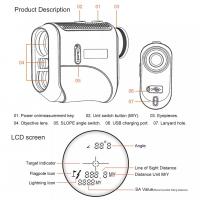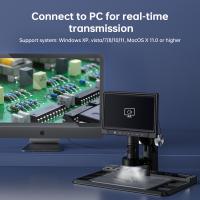Why Surveillance Cameras Are Important ?
Surveillance cameras are important for several reasons. Firstly, they help deter crime by acting as a visible deterrent to potential criminals. The presence of cameras can make individuals think twice before engaging in illegal activities, as they know their actions are being recorded. Secondly, surveillance cameras aid in the investigation and prevention of crimes. They provide valuable evidence that can be used to identify and apprehend criminals, as well as to support legal proceedings. Additionally, surveillance cameras can enhance public safety by monitoring public spaces and alerting authorities to any suspicious or dangerous activities. They can also be used to monitor traffic and ensure compliance with traffic laws. Overall, surveillance cameras play a crucial role in maintaining security, preventing crime, and promoting public safety.
1、 Crime prevention and deterrence
Surveillance cameras are important for crime prevention and deterrence for several reasons. Firstly, the presence of cameras can act as a deterrent to potential criminals. Knowing that they are being watched and recorded can make individuals think twice before engaging in illegal activities. This can help reduce the occurrence of crimes such as theft, vandalism, and assault in public spaces.
Secondly, surveillance cameras provide valuable evidence in criminal investigations. In the event of a crime, the footage captured by cameras can be used to identify suspects, track their movements, and provide crucial evidence for prosecution. This can greatly assist law enforcement agencies in solving crimes and bringing perpetrators to justice.
Furthermore, surveillance cameras can help enhance public safety. By monitoring public spaces, cameras can quickly detect and respond to emergencies such as accidents, fires, or acts of terrorism. This allows for a more rapid response from emergency services, potentially saving lives and minimizing damage.
In recent years, the importance of surveillance cameras has been further emphasized by advancements in technology. The development of high-definition cameras, facial recognition software, and artificial intelligence has significantly improved the effectiveness of surveillance systems. These technologies enable quicker identification of suspects, more accurate monitoring of crowded areas, and the ability to detect suspicious behavior patterns.
However, it is important to strike a balance between the benefits of surveillance cameras and individual privacy rights. Proper regulations and guidelines should be in place to ensure that the use of surveillance cameras is transparent, accountable, and respects the privacy of individuals.
In conclusion, surveillance cameras play a crucial role in crime prevention and deterrence. They act as a deterrent to potential criminals, provide valuable evidence for investigations, and enhance public safety. With advancements in technology, surveillance systems have become more effective in identifying suspects and detecting suspicious activities. However, it is essential to maintain a balance between the benefits of surveillance and individual privacy rights.

2、 Gathering evidence for investigations and prosecutions
Surveillance cameras play a crucial role in gathering evidence for investigations and prosecutions. They provide a visual record of events that can be used to identify suspects, establish timelines, and corroborate witness testimonies. This evidence is invaluable in solving crimes and ensuring that justice is served.
In recent years, the importance of surveillance cameras in investigations has only grown. With advancements in technology, these cameras have become more sophisticated, offering higher resolution images and improved video analytics. This allows law enforcement agencies to capture clearer footage, even in low-light conditions, and enhance it for better identification of individuals involved in criminal activities.
Moreover, surveillance cameras are now more widely deployed in public spaces, commercial establishments, and residential areas. This expanded coverage increases the chances of capturing crucial evidence, as it provides a comprehensive view of the surroundings where crimes may occur. Additionally, the presence of cameras acts as a deterrent, discouraging potential criminals from engaging in illegal activities.
Furthermore, the rise of social media and the widespread use of smartphones have made it easier for surveillance footage to be shared and analyzed by the public. This crowdsourcing of information has proven to be a valuable tool in investigations, as it allows for a wider pool of individuals to review the footage and potentially identify suspects or provide additional context.
However, it is important to strike a balance between the benefits of surveillance cameras and individual privacy rights. Safeguards must be in place to ensure that the use of these cameras is proportionate and respects privacy laws. Transparency and accountability in the use of surveillance technology are crucial to maintain public trust and confidence.
In conclusion, surveillance cameras are important for gathering evidence in investigations and prosecutions. They provide a visual record that can aid in identifying suspects, establishing timelines, and corroborating witness testimonies. With advancements in technology and wider deployment, these cameras have become even more effective in solving crimes. However, it is essential to ensure that their use is balanced with individual privacy rights and subject to appropriate safeguards.

3、 Monitoring public spaces for safety and security
Surveillance cameras are important for monitoring public spaces for safety and security. They play a crucial role in deterring crime, assisting law enforcement in investigations, and providing evidence in legal proceedings. The presence of surveillance cameras acts as a deterrent to potential criminals, as they are aware that their actions are being recorded and can be used against them in court. This helps create a safer environment for both residents and visitors.
In recent years, there has been a growing concern about public safety due to various incidents of violence and terrorism. Surveillance cameras have become an essential tool in preventing and responding to such threats. They enable law enforcement agencies to monitor public spaces in real-time, allowing for quick response to any suspicious activities or emergencies. Additionally, the footage captured by these cameras can provide valuable evidence in identifying and apprehending suspects involved in criminal activities.
Moreover, surveillance cameras have evolved with advancements in technology. The latest cameras are equipped with high-resolution capabilities, facial recognition software, and intelligent video analytics. These features enhance their effectiveness in identifying individuals and detecting unusual behavior. For instance, facial recognition technology can help identify known criminals or persons of interest, aiding law enforcement in their investigations.
However, it is important to strike a balance between public safety and privacy concerns. The use of surveillance cameras should be regulated and transparent to ensure that they are not misused or infringe upon individuals' privacy rights. Proper guidelines and oversight are necessary to ensure that the data collected by these cameras is used solely for public safety purposes and not for unauthorized surveillance.
In conclusion, surveillance cameras are important for monitoring public spaces for safety and security. They act as a deterrent to crime, assist law enforcement in investigations, and provide valuable evidence. With the latest advancements in technology, surveillance cameras have become even more effective in ensuring public safety. However, it is crucial to maintain a balance between public safety and privacy concerns to ensure that these cameras are used responsibly and ethically.

4、 Enhancing traffic management and road safety
Surveillance cameras play a crucial role in enhancing traffic management and road safety. These cameras are strategically placed in various locations to monitor and record traffic activities, providing valuable information to authorities and helping them make informed decisions. Here's why surveillance cameras are important in this context:
1. Accident prevention: Surveillance cameras can detect and monitor potential hazards on the road, such as reckless driving, speeding, or illegal maneuvers. By capturing these incidents, authorities can take appropriate actions to prevent accidents and ensure the safety of both drivers and pedestrians.
2. Traffic flow optimization: Surveillance cameras provide real-time data on traffic congestion, allowing authorities to identify areas with heavy traffic and implement measures to improve the flow. This can include adjusting traffic signal timings, redirecting vehicles, or deploying additional resources to manage the situation effectively.
3. Law enforcement: Surveillance cameras act as a deterrent to traffic violations and other illegal activities. Knowing that they are being monitored, drivers are more likely to adhere to traffic rules, reducing the number of accidents and ensuring a safer environment for everyone.
4. Evidence collection: In the unfortunate event of an accident or crime, surveillance cameras serve as crucial evidence. The recorded footage can help authorities reconstruct the incident, identify the responsible parties, and ensure justice is served.
5. Technological advancements: With the latest advancements in surveillance technology, cameras can now be equipped with features like license plate recognition, facial recognition, and object tracking. These capabilities enable authorities to quickly identify and apprehend offenders, enhancing overall road safety.
In conclusion, surveillance cameras are essential for enhancing traffic management and road safety. They provide valuable data, aid in accident prevention, optimize traffic flow, enforce traffic laws, and serve as evidence in legal proceedings. As technology continues to advance, surveillance cameras will play an even more significant role in ensuring the safety and efficiency of our roadways.







































